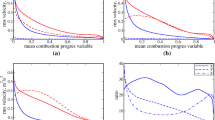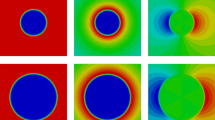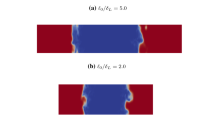Abstract
Three different methods to introduce turbulence in the computational domain of Direct Numerical Simulations (DNS) of statistically planar turbulent premixed flame configurations have been reviewed and their advantages and disadvantages in terms of run time, natural flame development, control of turbulence parameters and convergence of statistics extracted from the simulations have been discussed in detail. It has been found that there is no method, which is clearly superior to the other two alternative methods. An analysis has been performed to explain why Lundgren’s physical space linear forcing results in an integral length scale which is, independent of the Reynolds number, a constant fraction of the domain size. Furthermore, an evolution equation for the integral length scale has been derived, and a scaling analysis of its terms has been performed to explain the evolution of the integral length scale in the context of Lundgren’s physical space linear forcing. Finally, a modification to Lundgren’s forcing approach has been suggested which ensures that the integral length scale settles to a predetermined value so that DNS of statistically planar turbulent premixed flames with physical space forcing can be conducted for prescribed values of Damköhler and Karlovitz numbers.












Similar content being viewed by others
References
Trouvé, A.: The production of premixed flame surface area in turbulent shear flow. Combust. Flame 99, 687–696 (1994)
Chakraborty, N., Klein, M., Cant, R.S.: Effects of turbulent reynolds number on the displacement speed statistics in the thin reaction zones regime of turbulent premixed combustion. J. Combust. 2011, Article ID 473679 (2011)
Han, I., Huh, K.Y.: Roles of displacement speed on evolution of flame surface density for different turbulent intensities and Lewis numbers in turbulent premixed combustion. Combust. Flame 152, 194–205 (2008)
Kim, S.H., Pitsch, H.: Scalar gradient and small-scale structure in turbulent premixed combustion. Phys. Fluids 19, 115114 (2007)
Rogallo, R.S.: Numerical Experiments in Homogeneous Turbulence, NASA Technical Memorandum, vol. 81315. NASA Ames Research Center, California (1981)
Rutland, C.J., Cant, R.S.: Turbulent transport in premixed flames.. In: Proceedings of Summer Program, Center for Turbulence Research, pp. 75–94 (1994)
Nishiki, S., Hasegawa, T., Borghi, R., Himeno, R.: Modelling of turbulent scalar flux in turbulent premixed flames based on DNS databases. Combust. Theor. Model. 10(1), 39–55 (2006)
Chakraborty, N., Cant, S.: Unsteady effects of strain rate and curvature on turbulent premixed flames in an inflow–outflow configuration. Combust. Flame 137, 129–147 (2004)
Aspden, A.J., Day, M. S., Bell, J.B.: Turbulence-flame interactions in lean premixed hydrogen: transition to the distributed burning regime. J. Fluid Mech. 680, 287–320 (2011)
Poludnenko, A.Y., Oran, E.S: The interaction of high-speed turbulence with flames: global properties and internal flame structure. Combust. Flame 157, 995–1011 (2010)
Savard, B., Blanquart, G.: Broken reaction zone and differential diffusion effects in high Karlovitz n-C7H16 premixed turbulent flames. Combust. Flame 162, 2020–2033 (2015)
Lundgren, T.: Linear Forced Isotropic Turbulence in Annual Research Briefs. Center for Turbulence Research, Stanford, pp. 461–473 (2003)
Rosales, C, Meneveau, C.: Linear forcing in numerical simulations of isotropic turbulence: physical space implementations and convergence properties. Phys. Fluids 17, 095106 (2005)
Carroll, P.L., Blanquart, G.: A proposed modification to Lundgren’s physical space velocity forcing method for isotropic turbulence. Phys. Fluids 25, 105114 (2013)
Carroll, P.L., Blanquart, G.: The effect of velocity field forcing techniques on the Karman–Howarth equation. J. Turbul. 15, 429–448 (2014)
Jenkins, K.W., Klein, M., Chakraborty, N., Cant, R.S: Effects of strain rate and curvature on the propagation of a spherical flame kernel in the thin-reaction-zones regime. Combust. Flame 145, 415–434 (2006)
Chakraborty, N., Klein, M., Cant, R.S.: Stretch rate effects on displacement speed in turbulent premixed flame kernels in the thin reaction zones regime. Proc. Combust. Inst. 31, 1385–1392 (2007)
Klein, M., Sadiki, A., Janicka, J.: A digital filter based generation of inflow data for spatially develo** direct numerical or large eddy simulations. J. Comp. Physics 186, 652–665 (2003)
Chakraborty, N., Cant, R.S.: Effects of Lewis number on flame surface density transport in turbulent premixed combustion. Combust. Flame 158, 1768–1787 (2011)
Chakraborty, N., Wang, L., Klein M.: Streamline segment statistics of premixed flames with nonunity Lewis numbers. Phys. Rev. E 89, 033015 (2014)
Matalon, M., Matkowsky, B.J.: Flames as gasdynamic discontinuities. J. Fluid Mech. 124, 239–259 (1982)
Chaudhuri, S., Akkerman, V., Law, C.K.: Spectral formulation of turbulent flame speed with consideration of hydrodynamic instability. Phys. Rev. E 84, 026322 (2011)
Denet, B., Haldenwang, P.: A numerical study of premixed flames Darrieus-landau instability. Combust. Sci. Tech. 104, 143–167 (1995)
Tennekes, H, Lumley, J.L.: A First Course in Turbulence, 1st edn. MIT Press, Cambridge (1972)
Corless, R.M., Gonnet, G.H., Hare, D.E.G., Jeffrey, D.J., Knuth, D.E.: On the Lambert W function. Adv. Compos. Mater. 5, 329–359 (1996)
Pope, S.B.: Turbulent Flows. Cambridge University Press, Cambridge (2000)
Wacks, D.H., Chakraborty, N., Klein, M., Arias, P.G., Im, H.G.: Flow topologies in different regimes of premixed turbulent combustion: A direct numerical simulation analysis. Phys. Rev. Fluids 1, 083401 (2016)
Ashurst, W., Kerstein, A., Kerr, R.M., Gibson, C.H.: Alignment of vorticity and scalar gradient with strain rate in simulated Navier–Stokes turbulence. Phys. Fluids A 30, 2343 (1987)
Majda, A.J.: Vorticity, turbulence, and acoustics in fluid flow. SIAM Rev. 33, 349 (1991)
Jimenez, J.: Kinematic alignment effects in turbulent flows. Phys. Fluids A 4, 652 (1992)
Batchelor, G., Townsend, A.: The nature of turbulent motion at large wave-numbers. In: Proceedings of the Royal Society of London A: Mathematical, 240 Physical and Engineering Sciences, volume 199, The Royal Society, pp. 238–255 (1949)
Monin, A.S., Yaglom, A.M.: Statistical Fluid mechanics, volume II: Mechanics of turbulence, volume 2. Courier Corporation (2013)
She, Z.-S., Jackson, E., Orszag, S.A.: Scale-dependent intermittency and coherence in turbulence. J. Sci. Comput. 3, 407–434 (1988)
Yamamoto, K., Kambe, T.: Gaussian and near-exponential probability distributions of turbulence obtained from a numerical simulation. Fluid Dyn. Res. 8, 65–72 (1991)
Mallouppas, G., George, W.K., van Wachem, B.G.M.: New forcing scheme to sustain particle-laden homogeneous and isotropic turbulence. Phys. Fluids 25, 083304 (2013)
Eswaran, V., Pope, S.B.: An examination of forcing in direct numerical simulations of turbulence. Comput. Fluids 16, 257–278 (1988)
Acknowledgments
Support by the German Research Foundation (Deutsche Forschungsgemeinschaft - DFG, GS: KL1456/1-1) is gratefully acknowledged. The authors are grateful to N8, ARCHER and grant number (EP/K025163/1) EPSRC for computational support.
Author information
Authors and Affiliations
Corresponding author
Ethics declarations
Conflict of interests
The authors declare that they have no conflict of interest.
Rights and permissions
About this article
Cite this article
Klein, M., Chakraborty, N. & Ketterl, S. A Comparison of Strategies for Direct Numerical Simulation of Turbulence Chemistry Interaction in Generic Planar Turbulent Premixed Flames. Flow Turbulence Combust 99, 955–971 (2017). https://doi.org/10.1007/s10494-017-9843-9
Received:
Accepted:
Published:
Issue Date:
DOI: https://doi.org/10.1007/s10494-017-9843-9




